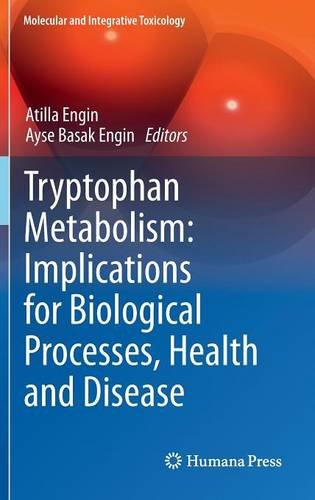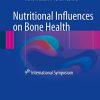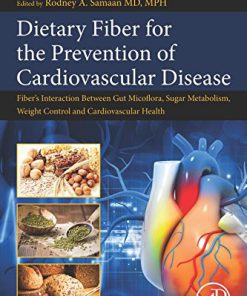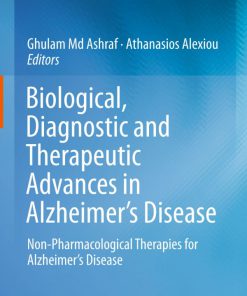Tryptophan Metabolism Implications for Biological Processes Health and Disease 2015th Edition by Atilla Engin 3319156309 9783319156309
$50.00 Original price was: $50.00.$25.00Current price is: $25.00.
Tryptophan Metabolism Implications for Biological Processes Health and Disease 2015th Edition by Atilla Engin – Ebook PDF Instant Download/DeliveryISBN: 3319156309, 9783319156309
Full download Tryptophan Metabolism Implications for Biological Processes Health and Disease 2015th Edition after payment.

Product details:
ISBN-10 : 3319156309
ISBN-13 : 9783319156309
Author: Atilla Engin
This book discusses the relationship between cellular immunity and tryptophan metabolism, as well as its products, serotonin and melatonin, in the development of several diseases and reappraises the common signal transduction pathways of the neurodegenerative diseases, carcinogenesis, immune tolerance, inflammation, hypersensitivity reactions, neuropsychiatric disorders, in addition to bacterial tryptophan biosynthesis and novel antimicrobials. Tryptophan Metabolism: Implications for Biological Processes, Health and Disease presents fundamental information on tryptophan related metabolic pathways and metabolites, implications of these products for specific biological processes, diseases and conditions. This book focuses on effects of tryptophan metabolites on human health and will appeal to researchers, clinicians and students within this field.
Tryptophan Metabolism Implications for Biological Processes Health and Disease 2015th Table of contents:
Chapter 1: Tryptophan-Related Signaling Molecules: Targets and Functions
1.1 Introduction
1.2 Cytokine-Mediated Signaling
1.3 IDO-Mediated Signaling
1.4 Aryl Hydrocarbon Receptor Activation
1.5 Glutamate Neurotransmission
1.6 Serotonin Neurotransmission
1.7 Desensitization and Re-sensitization of Serotonin Receptors
1.8 Enterochromaffin Cell and Serotonergic Signaling
1.9 Taste Receptor Signaling
1.10 Conclusion
References
Chapter 2: Tryptophan and Cell Death
2.1 Cell Death
2.2 Toxic Versus Protective Effect of Tryptophan Metabolites
2.3 Redox-Active Molecules, Mitochondria, and Tryptophan Metabolites
2.4 Tryptophan and Programmed Cell Death
2.5 Hypertryptophanemia
2.6 Hypoxic-Ischemic Brain Damage and Tryptophan
2.7 Conclusion
References
Chapter 3: Tryptophan and Nitric Oxide in Allergy
3.1 Tryptophan
3.2 Tryptophan and Its Influence on the Immune System
3.3 Types of Immune Response
3.3.1 Allergy
3.4 Tryptophan in Allergy
3.4.1 Nitric Oxide: Nitrite
3.4.2 Nitric Oxide and Tryptophan Metabolism
3.5 Food Antioxidants and Tryptophan Metabolism
3.6 Conclusion
References
Chapter 4: Tryptophan Metabolites: A Microbial Perspective
4.1 Introduction
4.2 Tryptophan Biosynthesis
4.2.1 Tryptophan Production in Bacterial Cells
4.2.2 Tryptophan Synthesis Inhibitors: Promising Antimicrobials
4.3 Tryptophan in Microbial Cell to Cell Signalling
4.3.1 Glow While Speaking
4.3.2 Indole as a Signal Molecule
4.3.3 Pseudomonas Quinolone Signalling
4.3.4 Antipathogenics: Taming the Wild Bacteria
4.4 Conclusion
References
Chapter 5: The Role of L-Tryptophan Kynurenine Pathway Metabolism in Various Infectious Diseases:
5.1 Regulatory Enzymes in L-Tryptophan-Kynurenine Pathway
5.2 TRP Metabolites in Peripheral Tissues and the CNS
5.3 Immune Regulation by IDO1
5.4 The Role of IDO1 and Its Metabolites in Various Infectious Diseases
5.4.1 Hepatitis Virus Infection
5.4.2 Human Immunodeficiency Virus (HIV) Infection
5.4.3 Influenza Virus Infection
5.4.4 Encephalomyocarditis Virus Infection
5.4.5 Toxoplasma gondii Infection
5.4.6 Chlamydia spp. Infection
5.4.7 Fungal Infection
5.5 Future Strategy Targeting the TRP-KYN Pathway
5.6 Conclusion
References
Chapter 6: Evaluation of Tryptophan Metabolism in Chronic Immune Activation
6.1 Introduction
6.2 Chronic Immune Activation in Inflammatory and Functional Bowel Diseases
6.3 Immune Escape Mechanism in Cancer
6.4 Aging and Chronic Immune Activation
6.5 Atherosclerosis
6.6 Human Hypertryptophanemia
6.7 Obesity-Related Chronic Immune Activation
6.8 Conclusion
References
Chapter 7: Diabetes and Tryptophan Metabolism
7.1 Introduction
7.2 Tryptophan Metabolism
7.2.1 Tryptophan–Kynurenine Pathway
7.2.2 Tryptophan–Methoxyindole Pathway
7.3 Diabetes Mellitus Definition and Classification
7.4 Diabetes Mellitus and Tryptophan Metabolism
7.4.1 Type 1 Diabetes
7.4.2 Type 1 Diabetes and Tryptophan Metabolism
7.4.3 Type 2 Diabetes Mellitus
7.4.4 Type 2 Diabetes and Tryptophan Metabolism
7.4.4.1 Type 2 Diabetes and Kynurenine Pathway
7.4.4.2 Type 2 Diabetes and Methoxyindole Pathway
7.4.4.2.1 Type 2 Diabetes and Serotonin
7.4.4.2.2 Type 2 Diabetes and Melatonin
7.4.5 Diabetic Complications and Tryptophan Metabolism
7.5 Conclusions
References
Chapter 8: 3-Hydroxykynurenic Acid and Type 2 Diabetes: Implications for Aging, Obesity, Depression,
8.1 Introduction
8.1.1 Upstream KYN Metabolic Pathways
8.1.2 Downstream KYN Metabolic Pathways
8.2 Regulation of Upstream KYN Metabolic Pathways
8.2.1 Inflammation
8.2.2 Stress
8.3 Regulation of Downstream KYN Metabolic Pathways
8.4 Diabetogenic Effects of KYN Derivatives
8.4.1 KYNA
8.4.2 3H-KYNA
8.5 Clinical Markers of Upregulation of TRP–KYN Pathway
8.6 Dysregulation of TRP–KYN Metabolism in T2D
8.6.1 Dysregulation of TRP–KYN Metabolism in Aging
8.6.2 Aging and TDO (Stress)
8.6.3 Inflammation and Aging: IDO
8.6.4 Inflammation and Aging: Neopterin
8.6.5 Aging and P5P
8.7 Dysregulation of TRP–KYN Metabolism in Obesity
8.7.1 P5P Deficiency
8.7.2 Dysregulation of TRP–KYN Metabolism in Depression
8.7.3 Dysregulation of TRP–KYN Metabolism in Depression Associated with Hepatitis C Virus
8.7.4 Dysregulation of TRP–KYN Metabolism in Parkinson’s Disease
8.7.5 Dysregulation of TRP–KYN Metabolism in Neurodegenerative Disorders
8.7.6 Dysregulation of TRP–KYN Metabolism in Schizophrenia
8.8 Conclusion
References
Chapter 9: Therapeutical Implications of Melatonin in Alzheimer’s and Parkinson’s Diseases
9.1 Introduction
9.2 Basic Biology of Melatonin Relevant to Neurodegeneration
9.3 Basic Aspects of Melatonin Activity in Animal Models of AD
9.4 Clinical Aspects of Melatonin Application in AD
9.5 Basic Aspects of Melatonin Activity in Animal Models of PD
9.6 Clinical Aspects of Melatonin Application in PD
9.7 Conclusions
References
Chapter 10: Tryptophan Metabolism and Sleep
10.1 Sleep
10.2 Tryptophan and Sleep
10.2.1 Effect of Tryptophan Administration on Sleep Parameters in Healthy Populations
10.2.2 Effect of Tryptophan Administration on Sleep Parameters in Insomnia Patients
10.2.3 Effect of Subchronic Tryptophan Administration on Sleep
10.2.4 Effect of Tryptophan Administration on Sleep and Cognition
10.2.5 Effect of Tryptophan Administration on Sleep in Infants and Children
10.3 Serotonin
10.4 Melatonin
10.4.1 Effect of Melatonin on Sleep
10.4.2 Effect of Melatonin on Sleep Architecture
10.4.3 Melatonin and Age
10.4.4 Melatonin and Insomnia
10.4.5 Melatonin and Jet Lag
10.4.6 Melatonin Agonists
10.5 Obstructive Sleep Apnea Syndrome (OSAS)
10.5.1 Effects of Tryptophan and Its Metabolites on OSAS
References
Chapter 11: Tryptophan in Molecular Hematopoiesis
11.1 Introduction
11.2 Molecular Hematopoiesis and Tryptophan
11.3 Cytokine Signaling, Tryptophan, and Hematopoiesis
11.4 Tryptophan Metabolism, IDO, and Blood Cells
11.5 Tryptophan Metabolic Pathways in the Leukemic Neoplastic Hematopoiesis
11.6 Conclusion
References
Chapter 12: Night Shifts and Melatonin: Relevance to Age and Breast Cancer
12.1 Biological Clock
12.2 Melatonin and Circadian Rhythm
12.3 Sirtuins, Melatonin, and Circadian Rhythm
12.4 Night Shift
12.4.1 Night Shift and Breast Cancer
12.5 Conclusion
References
Chapter 13: Chemotherapeutic Agents in Cancer Treatment and Tryptophan Metabolism
13.1 Introduction
13.2 Cancer Chemotherapy
13.2.1 Cell Cycle
13.2.2 Classification of Chemotherapeutic Agents
13.2.2.1 Classification According to the Factors Such as the Way They Work, Their Chemical Stru
13.2.2.2 Classification of Chemotherapeutics According to Their Activities During the Cell Cycle
13.3 Tryptophan Metabolism and Cancer Chemotherapy
13.3.1 The Use of IDO Inhibitors with Chemotherapy and/or Tumor Vaccines
13.3.2 Tryptophan Catabolites as Disease Biomarkers
13.3.3 Tryptophan Metabolism and Cancer-Related Fatigue
13.3.4 Melatonin and Cancer Chemotherapy
13.3.4.1 Melatonin
13.3.4.2 Anticancer Effects of Melatonin
13.3.4.3 Melatonin and Cancer Treatment
13.3.4.4 Melatonin and Chemotherapy Side Effects
13.3.4.5 Chronochemotherapy
13.4 Conclusion
References
Chapter 14: Indoleamine 2,3-Dioxygenase-Competent Regulatory Dendritic Cells and Their Role in All
14.1 Introduction
14.2 T-cell Tolerance
14.3 Mechanism of Transplant Tolerance
14.4 Contribution of IDO to Metabolic Immune Regulation
14.5 Mechanisms of Spontaneous Liver Transplant Tolerance
14.6 Conclusion
References
Chapter 15: Wine Flavor and Tryptophan
15.1 Introduction
15.2 Volatile Thiols and Wine Flavor
15.3 Fermentation Temperature
15.4 Yeast Assimilable Nitrogen and Wine
15.5 Untypical Aging Off-Flavor and Tryptophan
15.6 Oxidative and Osmotic Stress
15.7 Ethanol Stress and Quorum Sensing
15.8 Carnitine: Long-Chain Fatty Acids and Flavor Compounds
15.9 Melatonin and Wine
15.10 Conclusion
People also search for Tryptophan Metabolism Implications for Biological Processes Health and Disease 2015th:
tryptophan metabolism
tryptophan metabolism pathway
tryptophan metabolites
tryptophan metabolism disorders
l-tryptophan metabolism
Tags: Tryptophan, Metabolism, Implications, Biological Processes, Disease, Atilla Engin
You may also like…
Science (General)
Microbiota of the Human Body Implications in Health and Disease 1st Edition Andreas Schwiertz (Eds.)
Medicine
Social Pathways to Health Vulnerability Implications for Health Professionals Dula F. Pacquiao
Science (General)
Science (General)
Hydrogen Peroxide Metabolism in Health and Disease 1st Edition Hampton












